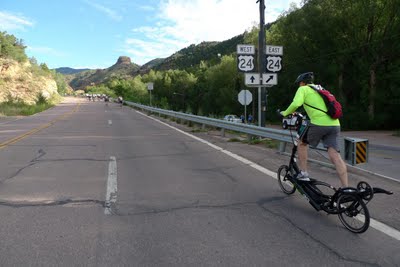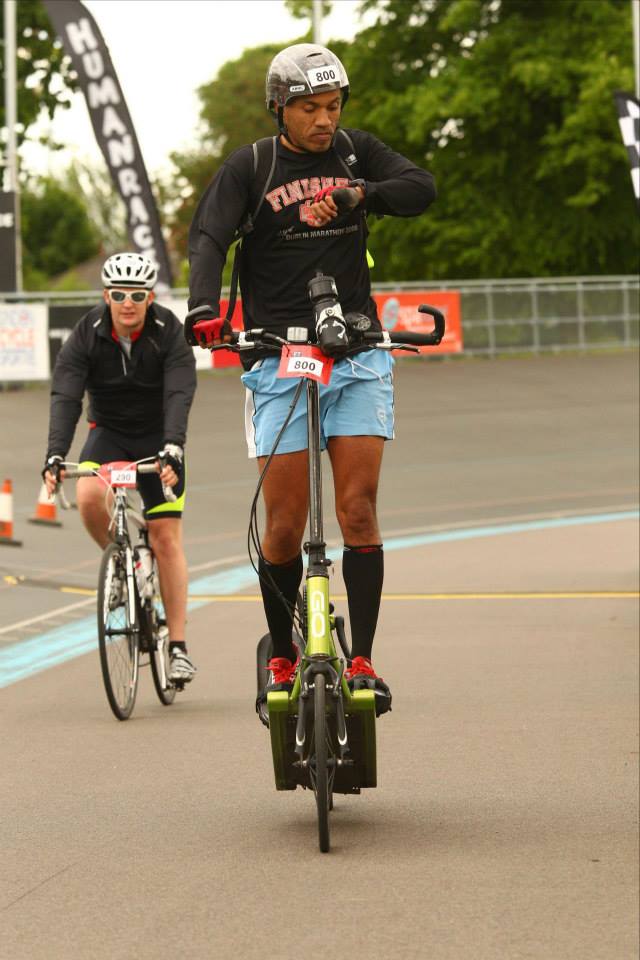By Idai Makaya (27 Jan 2015):
The article below is part of the training and preparation blog for the ElliptiGO Ultra Endurance Team 1,230-km (765-mile) Challenge at PBP 2015, which each rider was training to complete within the 90-hour time-limit…
I find that using the Heart Rate Monitor is the most scientific way to progress your long riding ability on the ElliptiGO, especially early on in the training program when building up training volume and intensity. This is because, with heart rate monitoring, you cannot have a tough ride – unless you actually want to.

The problem with riding ‘blind’ (as I call it), is that you don’t really know how hard you are working. If I say I am going out to average 135 bpm – and my max HR is 147 bpm – I know I will have a good ride, regardless of conditions or terrain.
If the terrain is tough, or there’s wind, the ride will take longer. If there’s no wind – and it’s flat – the ride will be faster. If you are unwell, your HR is often higher for less effort (or doesn’t rise as high as you normally would be able to do) and you ride slower for the same effort level. If you are well rested that same HR produces a fast performance. Etc, etc. But the ride is always the same.
Because the ride is always the same you can measure genuine effort and progress. When your body has adapted to your training you will get faster for the same effort. But because you never over-extend yourself, you will adapt faster and get fit faster than if your training intensity is erratic. It’s more scientific to monitor your effort via heart rate.
If you want to improve your ability to go longer, it is crucial to ride at a very stress free pace (determined as zone 2 or 3 on your HRM). You cannot go wrong doing this. You will not suffer during long rides and you will not develop an aversion towards doing long rides. It is okay just to observe just the upper HR limit – and you do not particularly have to have a lower limit alarm set up for the training zone (although you can do so if you want to).
Long rides are the basis of long distance endurance training for events like the Paris Brest Paris.
If the HR goes too high on a monitored ride an alarm rings and you know to back down immediately until the alarm stops ringing. There’s a discipline required to do this, but the parameters are easy to follow. On short rides you can pretty much do what you want. But for the big long ride, it must be scientific, because 90% of your ability for ultra-distance riding is developed in that one ride.
If you only do slow easy long rides – and nothing else – you are more likely to be more ready for PBP than by only doing hard training over much shorter distances. There is a place for both approaches in your training, but the long and steady ride is much more important than the shorter faster rides. Also, we are training for an event taking place in August 2015. So if you are pushing hard now (in your January training) you will be burned out by August.

If you take it easy now, you will see gradual (but consistent) improvements all the way until August – and that feedback is really motivational (and engaging). There will be ups and downs along the way – you won’t always be motivated. But seeing progress will keep you engaged and make it more enjoyable than if you were to peak too soon.
My best preparation year was 2013 when I did LEL 2013. I wasn’t always where I needed to be in my fitness training, but there was a very linear progression and I set almost all my PBs (from 20-miles to 70-miles) in just one training ride – 2 weeks before the LEL 2013 event. That fast training ride gave me huge confidence going into the event itself. I didn’t do any serious training after that personal best ride because I had wanted to finish my preparation on a high.
If I went out again and could not reproduce that performance I would feel like I was sliding backwards, or it was a fluke. So I refused to allow myself to find that out. My 70-mile training ride was my fastest paced ride that year over every distance from 10 miles to 70 miles. I think that was because I had built up really slowly towards the event, but really consistently.
The physical and scientific aspect is crucial to get in shape for PBP but never forget the mind game. You don’t want to be second-guessing yourself, or doubting yourself. The qualifiers really help with this. But also your everyday training. If you realise there is nothing to prove until summer time you will have no pressure. You don’t need to do your best ride every time. You just need to enjoy the riding and know you have got out of it what you were supposed to get out of it.
To do that, you need to mentally ‘isolate’ yourself and follow your heart rate. You ride your own ride. You use YOUR heart rate. If someone overtakes you on your long ride you accept it. You do not break the code. You maintain YOUR discipline. If you see a guy on the horizon and you think you can catch him – remember he’s on a road bike – and he is not training for PBP on an ElliptiGO. He’s probably not even riding as far as you are. You are not on the same planet (training-wise). You do not have to chase him down. You must maintain YOUR discipline.
The long ride is sacred.
It must not be violated with indiscipline. On your work commutes or short training rides go fast, go slow, do whatever you want. It doesn’t matter. Only the long ride matters – and that must be perfect. Ride to destinations you have never visited. Work out new routes. But make the long ride interesting – and keep it scientific.
You will gain incredible fitness of you do this. Also – no breaks when doing your peak distance long ride training. You must aim not to stop at all on the long ride and focus mainly on comfort and self sufficiency. Only stop for the toilet. Eat as you ride.
Regarding eating, this can be THE key to long distance success. EAT EVERY HOUR – ON THE HOUR. Eat to the clock. Your eating should NOT be based on how you feel – or when it suits you – it should be ON THE HOUR, EVERY HOUR. I hope I have emphasised this enough. You CAN eat your way to success in an ultra ride. Regular drinking is important too – and your urine should be very lightly coloured on long rides (i.e. not dark yellow).

ALSO – do not waste time with sports nutrition products for Audax – they can actually make it harder sometimes by causing dips in energy flow leading to what is commonly called ‘bonking’. So no gels needed for regular fuel and sugar drinks are not essential either. If you are riding in HR zone 2 or 3 you should be fine subsisting on simple food.
Sandwiches work very well. So do Cliff Bars – any dense, slow-release foods. But the truth is, even if you eat chocolate bars they will work, but you must not ‘break the chain’ when it comes to energy flow. You must eat every hour – whether or not you feel like it.
There must be substantial calories in each hourly snack. Don’t make them vary too much in energy content. It is about the amount of calories taken in each hour. I think most of us in the ElliptiGO team will need about 250 calories per hour to keep the chain intact. That’s about a Mars bar, or snickers, or sandwich – EVERY HOUR.
As you get fitter the need for food reduces considerably. But when building up you must ‘over eat’. As you become more efficient and fitter you don’t eat less regularly, you just eat less food every hour – on the hour. The space between meals is key. You can’t really eat too often, only too infrequently. So eating smaller snacks every 45 minutes is okay, but eating larger ones – more than an hour apart – is not viable.
Pacing your effort and eating consistently and evenly across the ride – every hour – are actually the 2 most important skills for covering long distances like PBP, as a matter of course. People who ride long distances without batting an eyelid do so because they have a complete understanding of energy flow and pacing. Breaking the energy flow – or peaks in the pace/HR – ruin long rides.
Even a few indiscretions (for just a couple of minutes at a time in a long ride) can ruin an entire century ride. Don’t fluctuate your effort. In training effort must not go up by much – even on the hills – just keep it within the band.
For a more general article on Heart Rate Monitoring for Cycling in general, please click here. The linked article is not aimed at ultra endurance or ElliptiGO cycling, but the general principles do still apply.
NB: Although I train fasted – to improve my fat metabolism and general energy efficiency – I still follow the above rules rigorously in actual endurance events. Fasted training uses a different energy metabolism but as soon as you eat any calories at all on the day of a training ride the above rules will apply.
